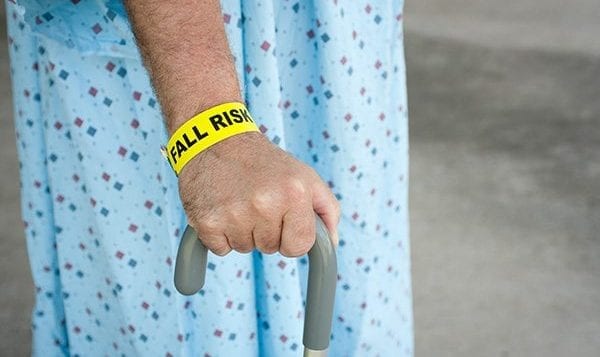Medical Compass: Reduce your risk of falling
Increased risk can begin at the age of 45
By David Dunaief, M.D.

When we are young, falls usually do not result in significant consequences. However, when we reach middle age and chronic diseases become more prevalent, falls become more substantial. And, unfortunately, falls are a serious concern for older patients, where consequences can be devastating. They can include brain injuries, hip fractures, a decrease in functional ability and a decline in physical and social activities (1). Ultimately, falls can lead to loss of independence (2).
Of those over the age of 65, between 30 and 40 percent will fall annually (3). Most of the injuries that involve emergency room visits are due to falls in this older demographic (4).
What can increase the risk of falls?
Many factors contribute to fall risk. A personal history of falling in the recent past is the most prevalent. But there are many other significant factors, such as age; being female; and using drugs, like antihypertensive medications used to treat high blood pressure and psychotropic medications used to treat anxiety, depression and insomnia.
Chronic diseases, including arthritis, as an umbrella term; a history of stroke; cognitive impairment and Parkinson’s disease can also contribute. Circumstances that predispose us to falls also involve weakness in upper and lower body strength, decreased vision, hearing disorders and psychological issues, such as anxiety and depression (5).
How do we prevent falls?
Fortunately, there are ways to modify many risk factors and ultimately reduce the risk of falls. Of the utmost importance is exercise. But what do we mean by “exercise”? Exercises involving balance, strength, movement, flexibility and endurance, whether home based or in groups, all play significant roles in fall prevention (6). We will go into more detail below.
Many of us in the Northeast suffer from low vitamin D, which may strengthen muscle and bone. This is an easy fix with supplementation. Footwear also needs to be addressed. Nonslip shoes, if recent winters are any indication, are of the utmost concern. Inexpensive changes in the home, like securing area rugs, can also make a big difference.
Medications that exacerbate fall risk
There are a number of medications that may heighten fall risk. As I mentioned, psychotropic drugs top the list. Ironically, they also top the list of the best-selling drugs. But what other drugs might have an impact?
High blood pressure medications have been investigated. A propensity-matched sample study (a notch below a randomized control trial in terms of quality) showed an increase in fall risk in those who were taking high blood pressure medication (7). Surprisingly, those who were on moderate doses of blood pressure medication had the greatest risk of serious injuries from falls, a 40 percent increase. One would have expected those on the highest levels to have the greatest increase in risk, but this was not the case.
While blood pressure medications may contribute to fall risk, they have significant benefits in reducing the risks of cardiovascular disease and events. Thus, we need to weigh the risk-benefit ratio, specifically in older patients, before considering stopping a medication. When it comes to treating high blood pressure, lifestyle modifications may also play a significant role in treating this disease (8).
Where does arthritis fit into this paradigm?
In those with arthritis, compared to those without, there is an approximately two-times increased risk of two or more falls and, additionally, a two-times increased risk of injury resulting from falls, according to the Centers for Disease Control and Prevention (1). This survey encompassed a significantly large demographic; arthritis was an umbrella term including those with osteoarthritis, rheumatoid arthritis, gout, lupus and fibromyalgia.
Therefore, the number of participants with arthritis was 40 percent. Of these, about 13 percent had one fall and, interestingly, 13 percent experienced two or more falls in the previous year. Unfortunately, almost 10 percent of the participants sustained an injury from a fall. Patients 45 and older were as likely to fall as those 65 and older.
Why is exercise critical?
All exercise has value. A meta-analysis of a group of 17 trials showed that exercise significantly reduced the risk of a fall (9). If the categories are broken down, exercise had a 37 percent reduction in falls that resulted in injury and a 30 percent reduction in those falls requiring medical attention. Even more impressive was a 61 percent reduction in fracture risk.
Remember, the lower the fracture risk, the more likely you are to remain physically independent. Thus, the author summarized that exercise not only helps to prevent falls but also fall injuries. The weakness of this study was that there was no consistency in design of the trials included in the meta-analysis. Nonetheless, the results were impressive.
Unfortunately, those who have fallen before, even without injury, often develop a fear that causes them to limit their activities. This leads to a dangerous cycle of reduced balance and increased gait disorders, ultimately resulting in an increased risk of falling (10).
What specific types of exercise are useful?
Many times, exercise is presented as a word that defines itself. In other words: Just do any exercise and you will get results. But some exercises may be more valuable or have more research behind them. Tai chi, yoga and aquatic exercise have been shown to have benefits in preventing falls and injuries from falls.
A randomized controlled trial, the gold standard of studies, showed that those who did an aquatic exercise program had a significant improvement in the risk of falls (11). The aim of the aquatic exercise was to improve balance, strength and mobility. Results showed a reduction in the number of falls from a mean of 2.00 to a fraction of this level — a mean of 0.29. There was no change in the control group.
There was also a 44 percent decline in the number of patients who fell. This study’s duration was six months and involved 108 postmenopausal women with an average age of 58. This is a group that is more susceptible to bone and muscle weakness. Both groups were given equal amounts of vitamin D and calcium supplements. The good news is that many patients really like aquatic exercise.
Thus, our best line of defense against fall risk is prevention. Does this mean stopping medications? Not necessarily. But for those 65 and older, or for those who have “arthritis” and are at least 45 years old, it may mean reviewing your medication list with your doctor. Before considering changing your BP medications, review the risk-to-benefit ratio with your physician. The most productive way to prevent falls is through lifestyle modifications.
References: (1) MMWR. 2014; 63(17):379-383. (2) J Gerontol A Biol Sci Med Sci. 1998;53(2):M112. (3) J Gerontol. 1991;46(5):M16. (4) MMWR Morb Mortal Wkly Rep. 2003;52(42):1019. (5) JAMA. 1995;273(17):1348. (6) Cochrane Database Syst Rev. 2012;9:CD007146. (7) JAMA Intern Med. 2014 Apr;174(4):588-595. (8) JAMA Intern Med. 2014;174(4):577-587. (9) BMJ. 2013;347:f6234. (10) Age Ageing. 1997 May;26(3):189-193. (11) Menopause. 2013;20(10):1012-1019.
Dr. Dunaief is a speaker, author and local lifestyle medicine physician focusing on the integration of medicine, nutrition, fitness and stress management. For further information, visit www.medicalcompassmd.com or consult your personal physician.







